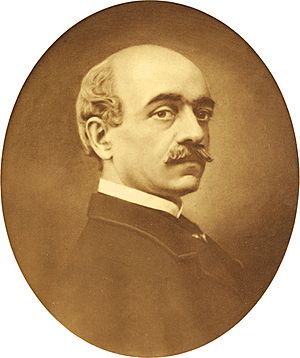Vasile Alecsandri facts for kids
Quick facts for kids
Vasile Alecsandri
|
|
|---|---|
 |
|
| Born | 21 July 1821 Bacău, Principality of Moldavia
|
| Died | 22 August 1890 (aged 69) Mircești, Kingdom of Romania
|
| Occupation | Poet, playwright, politician, and diplomat |
| Signature | |
 |
|
Vasile Alecsandri (born July 21, 1821 – died August 22, 1890) was a famous Romanian writer, politician, and diplomat. He was a strong supporter of his country and played a big part in the revolutions of 1848 in Moldavia and Wallachia.
Alecsandri worked hard to unite the Romanian regions. He wrote the popular song "Hora Unirii" in 1856, which means "The Union's Dance." He even gave up his chance to become the leader of Moldavia to support Alexandru Ioan Cuza, who helped unite the lands. Later, Vasile Alecsandri became Romania's first foreign affairs minister. He also helped start the Romanian Academy, a very important group for Romanian culture. He wrote many poems, stories, plays, and collected old Romanian folk tales. Many people see him as one of the most important Romanian writers of the 1800s.
Contents
Early Life and Education
Childhood in Moldavia
Vasile Alecsandri was born in Bacău, a town in Moldavia. His family was wealthy and involved in trading salt and grains. In 1828, his parents, Vasile Alecsandri and Elena Cozoni, bought a large estate in Mircești.
Young Vasile spent time there studying with a monk named Gherman Vida. He also played with a boy named Vasile Porojan, who became a good friend. Both these people later appeared in Alecsandri's writings.
School Days in Paris
From 1828 to 1834, Alecsandri went to a special boarding school in Iași. Then, in 1834, he moved to Paris, France. There, he tried studying different subjects like chemistry, medicine, and law. But he soon found his true passion: literature.
By 1838, he was writing his first literary pieces in French, a language he learned very well in Paris. After a short visit home, he traveled again, exploring Italy, Spain, and southern France.
A Sad Love Story
A year later, Alecsandri met Elena Negri at a party. He was 24, and she was 21. They fell in love, and Alecsandri started writing many love poems. Sadly, Elena became ill and had to go to Venice for treatment.
Alecsandri met her there, and they spent two special months together. They traveled to Austria, Germany, and France. But Elena's illness got worse in Paris. On April 25, 1847, while on a ship returning home, Elena died in Vasile's arms. He wrote a poem called "Steluța" (Little Star) to express his sadness. Later, he dedicated a whole collection of poems, "Lăcrimioare" (Little Tears), to her memory.
Midlife and Achievements
Joining the Revolution
In 1848, Vasile Alecsandri became a leader in the revolutionary movement in Iași. He wrote a famous poem, "Către Români" (To Romanians), which encouraged people to join the cause. This poem was later renamed "Deșteptarea României" (Romania's Awakening).
He also helped write an important statement for the revolution called "Dorințele partidei naționale din Moldova" (Wishes of the National Party of Moldavia). When the revolution failed, he had to leave Moldavia. He traveled through Transylvania and Austria, eventually reaching Paris, where he kept writing political poems.
Literary Success

After two years, Alecsandri returned home. His new comedy, "Chirița în Iași," was a big hit. He traveled around the Moldavian countryside, collecting and rewriting many Romanian folk tales. He published these in two popular collections in 1852 and 1853. These poems, especially ballads like "Miorița" and "Mânăstirea Argeșului," became very important for Romanian identity. His own poetry book, "Doine și Lăcrimioare," also made him very famous.
Alecsandri helped start "România Literară," a literary magazine where writers from both Moldavia and Wallachia could share their work. He strongly supported the idea of uniting these two Romanian regions. In 1856, he published "Hora Unirii" in a newspaper. This poem quickly became the anthem for the unification movement.
New Love and Family
In late 1855, Alecsandri fell in love with Paulina Lucasievici, the daughter of an innkeeper. He was 35, and she was much younger. They soon moved in together at his estate in Mircești. In 1857, their daughter, Maria, was born.
Political Success
Alecsandri saw his political dreams come true. The two Romanian regions united, and Alexandru Ioan Cuza appointed him as the Minister of External Affairs. Alecsandri traveled to Western countries, asking his friends and contacts in Paris to recognize the new nation and help it grow stronger in the Balkan area.
Life at Mircești
The diplomatic trips were tiring for Alecsandri. In 1860, he decided to settle down at his estate in Mircești, where he lived for the rest of his life. He married Paulina in 1876, more than a decade after their daughter was born.
Between 1862 and 1875, Alecsandri wrote 40 lyrical poems, including "Miezul Iernii" (Mid-Winter) and "Malul Siretului" (The Siret River Bank). He also wrote epic poems, collected in a book called "Legende." He dedicated a series of poems to the soldiers who fought in the Romanian War of Independence. He also wrote the words for the march "Drum bun" (Good Journey).
In 1879, his play "Despot-Vodă" won an award from the Romanian Academy. He continued to write a lot, finishing a fun comedy called "Sânziana și Pepelea" (1881) and two dramas, "Fântâna Blanduziei" (1883) and "Ovidiu" (1884).
In 1881, he wrote "Trăiască Regele" (Long Live the King), which became the national anthem of the Kingdom of Romania until 1947.
Vasile Alecsandri passed away in 1890 at his home in Mircești after a long illness.
Political Views
Vasile Alecsandri had an important political career. He was a strong supporter of ending slavery. He was also known for his nationalist views, which meant he deeply loved and supported his own country and its people.
See also
 In Spanish: Vasile Alecsandri para niños
In Spanish: Vasile Alecsandri para niños


